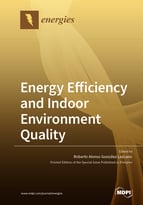Energy Efficiency and Indoor Environment Quality
A special issue of Energies (ISSN 1996-1073). This special issue belongs to the section "B: Energy and Environment".
Deadline for manuscript submissions: closed (30 September 2021) | Viewed by 29541
Special Issue Editor
Interests: efficient ventilation strategies; habits and comfort of the occupants; energy-efficient buildings; building codes and standards; indoor environmental quality; sustainable building materials; passive and active strategies; energy-saving strategies; lighting comfort; acoustic comfort; air quality monitoring; air pollution control; housing and health; HVAC control systems
Special Issues, Collections and Topics in MDPI journals
Special Issue Information
Dear Colleagues,
We currently live in a global context where climate change has paved the way for new initiatives to reduce carbon emissions. In light of this situation, the focus on GHG emissions management, the environmental impact of the built environment, and the optimization of environmental performance have become essential. Since most energy losses are due to air renovations and infiltrations, building ventilation has become a difficult challenge to improve energy management, as it is also closely related to human health and well-being. For this reason, it is vital that possible implementation techniques take into account the balance between indoor air quality and energy efficiency in the air renovations of buildings. Focusing on this will allow us to have a deeper understanding of buildings’ ventilation, as well as the quality of the air introduced. Original works that also deal with methodologies, numerical and experimental research, and case studies with a particular focus on the comfort conditions of the occupants and the influence of occupant habits in sustainable buildings and the effects of climate change on the built environment are welcome. Topics of interest include but are not exclusive to:
- Efficient ventilation strategies;
- Habits and comfort of the occupants;
- Energy efficient buildings;
- Building codes and standards;
- Sustainable building materials;
- Passive and active strategies;
- Energy-saving strategies;
- Air quality monitoring;
- Air pollution control;
- Housing and health;
- HVAC control systems.
Prof. Dr. Roberto Alonso González Lezcano
Guest Editor
Manuscript Submission Information
Manuscripts should be submitted online at www.mdpi.com by registering and logging in to this website. Once you are registered, click here to go to the submission form. Manuscripts can be submitted until the deadline. All submissions that pass pre-check are peer-reviewed. Accepted papers will be published continuously in the journal (as soon as accepted) and will be listed together on the special issue website. Research articles, review articles as well as short communications are invited. For planned papers, a title and short abstract (about 100 words) can be sent to the Editorial Office for announcement on this website.
Submitted manuscripts should not have been published previously, nor be under consideration for publication elsewhere (except conference proceedings papers). All manuscripts are thoroughly refereed through a single-blind peer-review process. A guide for authors and other relevant information for submission of manuscripts is available on the Instructions for Authors page. Energies is an international peer-reviewed open access semimonthly journal published by MDPI.
Please visit the Instructions for Authors page before submitting a manuscript. The Article Processing Charge (APC) for publication in this open access journal is 2600 CHF (Swiss Francs). Submitted papers should be well formatted and use good English. Authors may use MDPI's English editing service prior to publication or during author revisions.
Keywords
- indoor air quality
- renewable energy
- sustainable building
- occupant comfort
- ventilation systems
- sustainable architecture
- HVAC management
- occupant habits
- healthy building
- building energy performance
- building energy efficiency
- air pollution
- smart buildings
- TVOC






